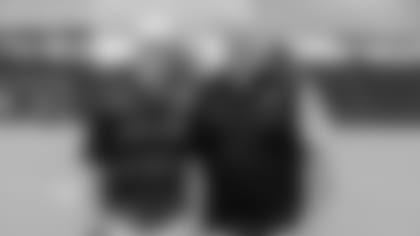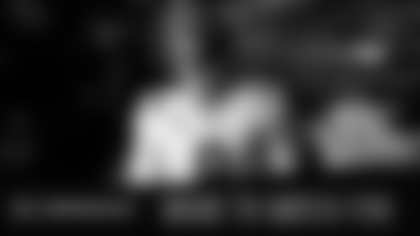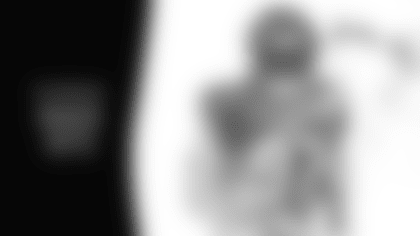Dan Hoard and Dave Lapham may have stayed behind last Thursday night in deserted Paul Brown Stadium with its Halloween eerie castle feel. But they showed why they belong at the front of NFL radio teams when they still managed to throw Bengaldom into the heart of its game 250 miles away against the Browns.
And they'll do it again as one of 15 NFL radio teams that didn't travel last week when they return to the big screens in their PBS booth Sunday for a 1 p.m. call on Cincinnati's ESPN 1530-AM and the rest of the Bengals Radio Network even though the Bengals are in Philadelphia.
"That's going to be interesting," Lapham says. "We may have to put a blanket around the windows to stop the light from creeping in."
For Hoard, the man with the precise pipes who can tame chaos with a sentence, it wasn't all that much different than when he was a kid. There were so many nights in his upstairs boyhood bedroom on the outskirts of Buffalo yelling into a tape recorder and at the TV as the Bills, Sabres, Braves and Mets beamed into Lakewood, N.Y.
"So, yeah," Hoard says. "I used to call games off a monitor for years."
Lapham, who has been doing this better than most anybody with a larynx, has been doing it four times longer than his decade as the most versatile offensive lineman in Bengals history. Same skill set, though. Eye-blink smart analysis, boundless energy and tell-it-like it-is-fourth-quarter blunt.
He did this once, calling games off a monitor, but it was during an audition for his national gig with Fox years back.
"We know it's not the best conditions," they told him, "but if you can do color off a monitor, all the better."
For Scott Simpson, the executive director of JungleVision that is home to the PBS scoreboards, it was better than that.
"That's the beauty of Dan and Lap. They work well together and they always have," Simpson says of a duo in its 10th season together. "They bring the energy into an empty stadium or a live house. To me, it sounded like they were just doing their job with no fans."
Simpson set them up with two huge screens on the front row where they usually sit in the booth while they settled into the second row. The 75-incher is the international feed that the network uses. "I'd like to have that in my family room," Hoard says. Next to it on the left is a 38-40-inch screen that shows every player on the field.
Hence its name. "The All-22." Since it was nighttime, the clarity was almost stunning. That's why Lapham is wondering how Sunday's sunlight might impact the visibility of the screens.
"You're in a man cave that's truly a massive cave," Lapham says. "Nothing behind (the screens)."
Usually, Hoard, his eyes on the ball, is looking at the big screen, and Lapham, his eyes on everything but the ball, is searching for clues on the All-22. But both need both.
"The All-22 gives a wide enough shot for blocking patterns, but only from tackle to tackle. By the time (the camera) gets to other areas, it's too late," Lapham says. "I try to get as wide as I can with my vision and they bring me back to where the ball is.
"I try to look at as much as I can and then everybody's movement and what's taking place takes me to the point of attack and along the way I find out who succeeded and who failed. Every once in a while they didn't stay as wide for as long as I hoped. But it was pretty darn good. I really can't complain."
Neither could Hoard. He never had to resort to the old Ronald Reagan radio baseball stories of banging a table to replace the crack of the bat. He was very impressed with how his engineer, the silent but deadly efficient Ted Ryan, synced up the audio off the feed with the call so the cadence of Joe Burrow's snap count in his first road NFL start was right on time.
Still, Hoard missed being able to scan his binoculars through the huddle and calling out who is in and out of the game, or being able to tell which players are in what formations. He did notice that NBC's Sunday Night feed flashed the names of skill players on the field before each snap, a graphic he wouldn't mind using for road games.
But other than that, it was solid. All except for not being able to tell the listener how many yards on a big play and where the ball sat for the next snap.
"You can't always see the numerals on the field like you can watching a game from the press box," Hoard says. "So when the TV cameraman zooms in on a ball carrier and he gets tackled or run out of bounds, by the time that happens you may not be able to see the numerals. So when you're trying to describe how many yards and where the play ended, you can't always tell on a TV screen, which I never consciously knew before."
Travel or no travel, you know Hoard is going to go back through his call to make notes on how to make the next one better.
"I may have to take a peek immediately from that screen to the higher angle in order to immediately identify where the ball is," Hoard plans.
The environment is far from a typical road game, where pregame the radio booth is a revolving door of guests and well-wishers and during the game is buzzing with a spotter and stat person. But the two stand-bys, Ryan and Dave "Yiddy" Armbruster, their producer with an air traffic controller's deadpan decisiveness, are still standing by. But that's pretty much it. Sometimes Simpson or Bengals chief marketing officer Brian Sells stops in to see how it's going and last week it was all good.
But with nobody on the field or in the seats, it was absolutely weird. Here Lap was calling how Burrow threw his first NFL touchdown pass and how he could hear a pin drop when C.J. Uzomah didn't.
"Bizarre," Simpson says. "But it's always bizarre down here when it's empty at night."
It's not totally barren. The digital crew is in the house and their pre-game potluck plans inspired Simpson to barbecue 10 slabs of ribs. He'll keep the grill on the JungleVision deck, but Sunday's volunteer is team reporter Marisa Contipelli and she'll be furnishing pancakes.
Meanwhile, Hoard is going to be flipping through both screens to see if he can get the right yard-line. That never seemed to be a problem when he was a kid tuned to the O.J. Simpson Buffalo Bills.
"I was just a kid yelling at the TV and having fun. I didn't know what a good job was. My call was probably, 'And Simpson goes for at least 20 yards,'" Hoard says. "Now I just have to wait a little longer than I normally would."
Bengaldom doesn't mind.







